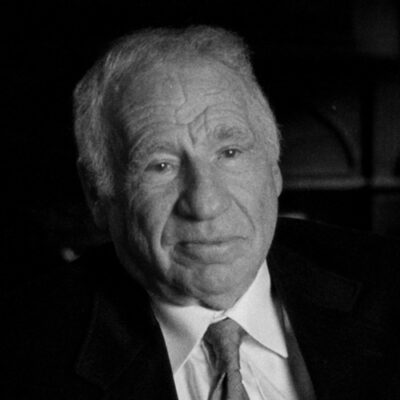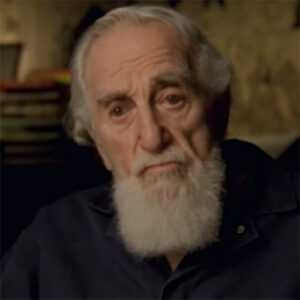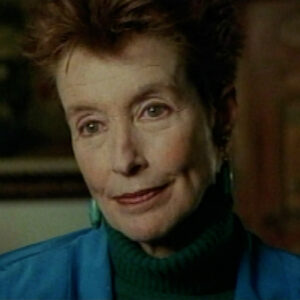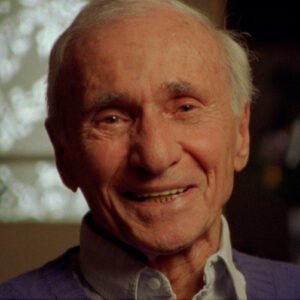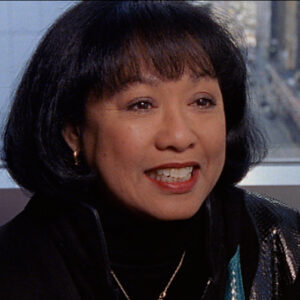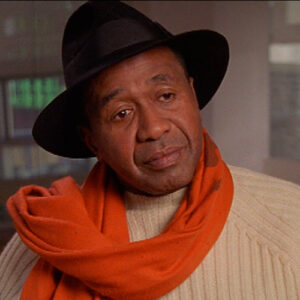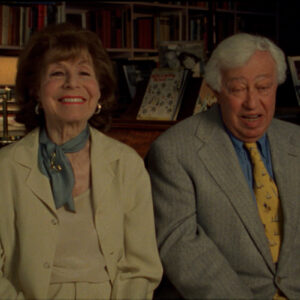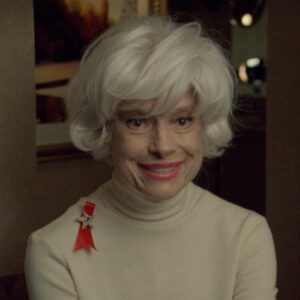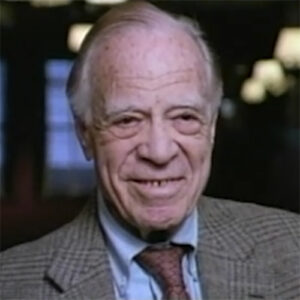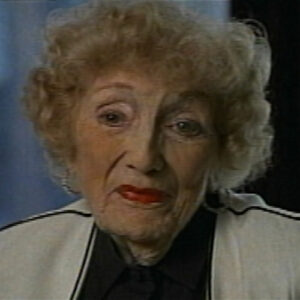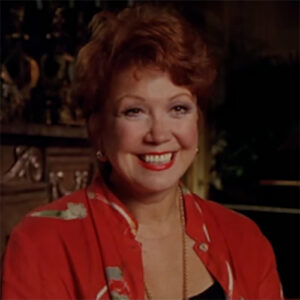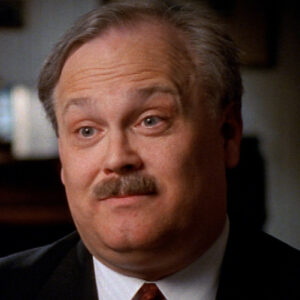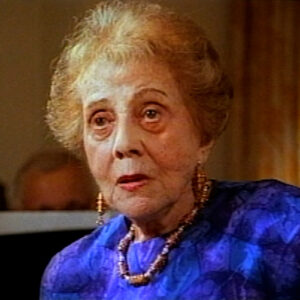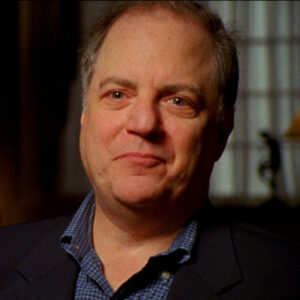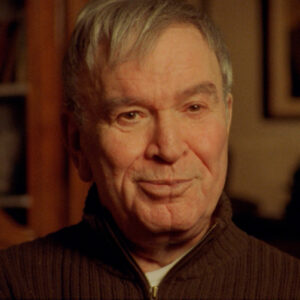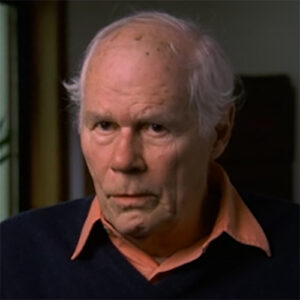Doris Eaton Travis: Ta-da-da, ta-da. That’s what I used to do.
Michael Kantor: So you can just walk out as though, you know, you’re walking onto the stage, and then when you get to the middle, say, I started in the Follies in 1918.
Doris Eaton Travis: Okay.
Michael Kantor: Take it, take, take them out. All right.
Doris Eaton Travis: Do you know what used to be here, right here? A huge switchboard. And there were two electricians. And they used to push things to change the lighting on the stage, pull it out to darken everything. They worked hard. But that’s not here anymore. Thank you very much. And neither are the footlights. There used to be beautiful footlights there when we’d come on stage. And of course, I started in the Follies in 1918 and I was just a chorus girl. So there were 24 of us that used to come out and do numbers on this stage. But in 1919, I became what they called a special girl. There were four of us. And we did little special things in different numbers. And I was Marilyn Miller’s understudy at that time. At one time, I had to go on for Maryland and… She was famous, of course, for the mandy routine that Irving Berlin wrote. And she used to do something, used to this sort of thing. That was part of the routine. I can remember it. And I had to learn it, and it was fun to do it. Marilyn was a lovely person. Then in 1920, of course, I was in the Follies again with my sister Mary, and then I became a full-fledged principal, and I had a solo. Mr. Siegfeld gave me a solo of my own. And it was an empty stage, And right back here was a great big… Box, like a big package. I used to get out of the box and come down and do my routine. I did a lot of high kicks and stuff like that. I don’t do that anymore. But this is fun to just remember and to be here on this stage once more. It’s just beautiful and lovely. And it’s a very fulfilling moment to be able to be here just once more.
Michael Kantor: Who was Florin Ziegfeld and tell us how he was always looking for different ideas to work into his show.
Doris Eaton Travis: Well, Floren Siegfeld was one of the greatest producers, I think, Broadway has ever had. In retrospect, at the time that I worked for him, I didn’t quite realize that, although I certainly had respect for the way he worked with the cast and the theater in his productions. I was aware that he was very interested in what was going on. He, uh… He always seemed to be looking for new ideas to incorporate into his shows and was very meticulous about many areas of it, the lighting, the costumes, the way the girls move, especially the tall, beautiful showgirls. He didn’t bother much about the hoofers. I was one of the hoofs, the tap dancers, the chorus girls. He didn’t bother much with us, but he was very. Concerned, it seemed, about the way the showgirls moved around the stage and how they looked.
Michael Kantor: What kind of man would you say he was? Tell us, he was at rehearsals a lot. Yes he was. And you got a sense of what kind of a man was he?
Doris Eaton Travis: Well, the only sense of what kind of man that I would have at that time at the age of 14 or 15 or 16 was that he was a man just taking care of his business on the theater. I was too young to have any other ideas about it. Sorry.
Michael Kantor: That’s great. Tell me about how, you know, he was always looking for ideas and he came up with this idea of incorporating bird feathers in, and that became his signature. Tell that story.
Doris Eaton Travis: Well, as I say, he was very meticulous about the costumes, even the costumes of the dancers, but particularly of the showgirls. And at one time, they had a costume that had a lot of bird feathers in it. Then they conceived the idea of having this huge peacock fan that would open up and the girl would. At the end of a parade, let’s say, of the showgirls and their different beautiful costumes, then that would be the climax. This final girl would come on with this big thing behind her and then open the fan in back of all the other girls with the girls on either side making a beautiful picture. So that he used for several years after when I was of the follies myself, but came to see them. He still used that, and he also used it up on the roof with the showgirls up there. I don’t know if you recall Dolores. She was a beautiful, tall blonde, and she usually did the peacock opening at the end of the number. Thank you very much. Have a great day.
Michael Kantor: Tell us how we’re sitting here in a loge box. Give us the name of the theater and tell us who would have sat here and how they might, what they would have been wearing.
Doris Eaton Travis: Well, this is the New Amsterdam Theater, where the Ziegfeld Follies held forth for years. This theater, I believe, this New Amsterdam theater, made 42nd Street. It was the center, and other theaters grew around it, trying to participate, let’s say, in the glamor and the romance and the beauty of this particular theater, because it is beautiful. The New Amsterdam Theater was the center of entertainment on 42nd Street. Many other theaters drove around it trying to participate in that. Success and popularity. And it was a theater that just presented all that was beautiful and elegant in show business. Mr. Siegfeld loved beautiful girls. And much of this is my retrospective thinking, of course, as I think back of the things that I saw. And he didn’t object to, let’s say, presenting the girls in a sensuous manner, but not a vulgar manner. His sensuousness was like a beautiful painting of the Renaissance period, when they painted these beautiful women. You couldn’t take offense, it was beauty. And that was the way that he presented his girls. They may have had some scant costumes. Moved beautifully and they looked beautiful.
Michael Kantor: Let me find out about some of the major talents in the show. I mean, you are one of the few people who saw and appreciated and saw from backstage Burt Williams.
Doris Eaton Travis: Yeah, Burt Williams, he was a very nice man. He was kindly. He didn’t push himself forward in any way. He was very modest. He’d come to the wings at the time for his particular number to go on. But he didn’t hang around the theater when he wasn’t doing his. And, as I say, was friendly. Pushing himself in any way, but just a pleasant person to talk to. The one I remember most was the one that, uh, nobody, I ain’t never done nothing to nobody. He was funny and just rich. His humor was just rich, unpretentious, but good, wholesome, funny.
Michael Kantor: He did a pantomime with a car.
Doris Eaton Travis: Oh, yes, his bridge game, or poker game, I guess it was. That was just outstanding.
Michael Kantor: Describe the difference between him and Eddie Cantor.
Doris Eaton Travis: Well, Eddie Cantor was very vigorous in his presentations of his numbers. He was moving all over the stage, clapping his hands, and was very athletic. Whereas Burt Williams just came out and stood in one spot, but you focused on him. But Eddie was just all over stage. Funny that way with some of his motions that he had.
Michael Kantor: And how about Fanny Brice? What was Fanny’s Brice’s charm?
Doris Eaton Travis: Fanny Brice was just a delightful individual. We all got to know her quite well. And we just loved her. When the Follies was over, she moved out to Hollywood and we were out there at that time. She and Pearl lived rather close to each other. And the children used to play together all the time. But in the shows, Fanny was just always just Fanny. Cheers. Always just a loving personality to me.
Michael Kantor: Describe one of her routines, either the swan dance or her, what kind of humor did she bring to her act?
Doris Eaton Travis: Let me see, Second Hand Rose was one of the songs that she sang. Always Wearing Second Hand Clothes. And it was just that type of humor that she brought into her songs, whoever wrote the songs for her. Then, but remember she also had great dramatic talent when she wrote my man, sang my man. Costs me a lot, but there’s one thing that I’ve got, it’s my man.” She was famous for that. So she had dramatic ability as well as comedy. She was just a comedian, the way she said things and moved with them. She was funny. She was a funny girl.
Michael Kantor: Tell us how you were in the 1919 Follies, which introduced the most famous song, I don’t know if, did Irving Berlin come and play it? How did, you know, Pretty Girls Like A Melody get worked in? But set it up, say, I was in the.
Doris Eaton Travis: I was in the 1919 Follies, which to me was one of the most beautiful follies that was ever presented. And in that show was the great song, A Pretty Girl is Like a Melody, which, to me, is the signature song of the Ziegfeld Follys, because that’s the motif. A pretty girl is like a melody. And that is what Flo Ziegfeld kept in his shows. A beautiful girl, like a beautiful melody. Fortunately, Irving Berlin evidently picked up the idea and wrote this marvelous song. John Steele sang it, and it was beautifully presented, so simple, so simply presented. The stage was empty. Picked up John Stiele, spotlighted it, and he sang the verse and chorus. Then there there were little verses taken from great melodies with lyrics. One of them was. Once I met a girly at the close of spring. I began to woo her, and she answered, yes, that’s summer. But when I went out to buy the wedding ring, she left me flat and ran off with the drummer. That was one of them. There was another one for Barkerow. At the opera, she said, my dear, I love you with all my soul, while the music filled up our ears. With Hoffenbach’s Barcarole. When the music died away, her love for me grew cold. And I found she told better tales than old Mr. Hoffman told. That was another of them. So with each of those segments, a girl would come on dressed in a costume referring to that mood. But you see, they were all the magnificent music of the years. And then at the end, the five girls would come on, and he’d sing the final chorus of A Pretty Girl Just Like a Melody. And they’d just walk toward the audience and back aways, and then they would pose. Simple, beautiful.
Michael Kantor: Thank you.
Doris Eaton Travis: I’m not a singer.
Michael Kantor: No, you’re beautiful. You mentioned what these shows had, which is not around anymore.
Doris Eaton Travis: They had beauty. Some of the shows have some beauty, but it’s a different kind of beauty, I have to say. But to me, the great quality of Flo Ziegfeld and his touch was elegance, refinement. The comedians. Wonderful humor but it wasn’t vulgarity it was
Michael Kantor: and romance. You mentioned.
Doris Eaton Travis: Oh, yes, the whole theater was just a romantic interlude for anybody that would come to see the show.
Michael Kantor: Marilyn Miller, what was her charm?
Doris Eaton Travis: She was young. Marilyn Miller was young, of course, in the 1918, 1919 follies that I was in with her. And this, of course, was the start of her great career, evidently, getting with Flo Ziegfeld in the follies. And to me, she was always friendly and laughing and happy, it seemed. But you must remember that I always saw these actors and actresses from a little different point of view than their intimates. I was never truly intimate with any of the members of the cast.
Michael Kantor: I read somewhere that Marilyn Miller looks innocent but could dance hot.
Doris Eaton Travis: But she was a good tap dancer, and she did some ballet dancing. She was not a great ballet dancer. I don’t say this egotistically. But she could not compare with my sister Mary as a ballet dancer, Mary really studied ballet. That was her heart and soul. But Marilyn learned it because it was another part of dancing for show business. And so she had a lovely ballet. But there was a lot of chorus girls along with it. But she was a good tap dancer. And. And she just could do what I call the light, fluffy dancing of a musical comedy. And Pennington’s dancing was even lighter than that, which I don’t mean to be critical. But the dancing was not that difficult. Today, what you see chorus girls do today, principals used to… Have to do in those years.
Michael Kantor: What did people think of Broadway back in the teens and 20s? Was it dangerous? Was it a place of opportunity?
Doris Eaton Travis: The Broadway that I remember in the years when my sister Pearl, my sister Mary and I, and my brother Charlie too, he was in the Follies in 1922, the Broadway we remember was bright, beautiful, active, everybody loved what they were doing. We used to have Sunday afternoon teas, so to speak. And one Sunday, they’d be at our place, Mary’s place. And then another Sunday, they would be at Marilyn’s place, and those afternoons, the people from the shows would come up and get together for just an afternoon of relaxation and talking with one another. B. Lilly used to come up, and Marilyn, of course. See, Oscar Levant was coming to the fore at that time, and he used to bring Gershwin up there. They’d sit and play the piano for everybody, and it was just a beautiful gathering of the folks of Broadway. And it was so lovely and enjoyable. I mean, nobody got drunk. It wasn’t that sort of thing. Mom always had delightful little caviar things that she used to fix and hut biscuits. And things of that kind. But it was kind of like a homie get together for some of the actors and actresses of the shows. Frank McHugh, he was a Nexus baggage with me one year.
Michael Kantor: So Broadway was like a small community.
Doris Eaton Travis: Yes, it was.
Michael Kantor: Give me that back if you would.
Doris Eaton Travis: Well, Broadway was like a small community of actors and actresses that enjoyed each other, appreciated what each other was doing, were proud of what they were doing, loved what they we’re doing, and we just shared it. We just shared, it was beautiful. I don’t get that feeling when I come to Broadway today.
Michael Kantor: Tell me who plays the lead in the film about the Ziegfeld following.
Doris Eaton Travis: Or Mary played the leading.
Michael Kantor: Now tell us, my sister…
Doris Eaton Travis: Oh, my sister Mary was selected to play the lead in Glorifying the American Girl, which was the story of Ziegfeld, Flo Ziegfel, developing the Follies Girl. And she was appointed to play that lead in that show. And Ziegfield even came onto the set a couple of times and I think he appeared in one two of the scenes with her.
Michael Kantor: Were you involved in the strike in 1919?
Doris Eaton Travis: Yes, I was. I wasn’t personally involved in it, but I’m aware of it. And of course, that’s when George M. Cohen was adamant about his position in it. And Eddie Cantor and Siegfeld, I believe, had quite a difficult situation over the Act of Strike at that time. As I learned later, they were very close at that time. Flo Ziegfeld was very upset with Eddie Cantor’s reactions to the strike. So it did affect, I’m sure, the background that I was not close to, but I could feel the tension that something unpleasant is going on. So I was only in 1919, I was 15.
Michael Kantor: What about Show Boat? What do you remember? Oh, sure. It was in this theater, right? In Amsterdam.
Doris Eaton Travis: No, no, no. The Ziegfeld Theater? Showboat opened the Ziegfel Theater up on 54th Street and 6th Avenue, and it was a magnificent performance. It was true flow Ziegfelt. Just a gorgeous, marvelous production. Acting and the singing and the story and everything, it was just, I just feel something never to be repeated.
Michael Kantor: What was it like when you walked out the stage door after the show?
Doris Eaton Travis: Well, sometimes you’d see a lot of men hanging around. And you just walk through them, that’s all, at least I did. But they talk a lot about the chorus girls and their talk in the chorus room and all that sort of thing. I heard a little of gossip back and forth, but my mother, of course, wanted me to just tend to my own business and not listen too hard. But They were a wonderful group of girls. And you know, if the stage door Johnnies hadn’t been there at the stage door pursuing their interests, the Ziegfeld chorus girls wouldn’t have anything to talk about. So let’s put a little blame where it should be.
Michael Kantor: That’s great. Was Broadway back then a place of opportunity? Wasn’t it a place people came from all over the country for their one shot, wasn’t it?
Doris Eaton Travis: Yes, well, I think Broadway is still a place of opportunity. It was the mecca, let’s say, for musical shows at that time. And of course, Hollywood blossomed from taking people from Broadway. Productions. So Broadway was the place to come and It was just alive with creativity, with production. But in 1919, they had about 51 theaters. Or not 19, not 1919, 1929, there were 50 shows on Broadway. And think of how much activity that created. So of course that would attract anybody that were trying to get into show business, where to go, Broadway.
Michael Kantor: Quick question about black culture, shuffle along. Well, you know, were there black acts in the follies and how did the sort of Harlem Renaissance affect Broadway?
Doris Eaton Travis: I don’t recall, at least in the follies that I was in, and I don’t recall other follies having any black performers other than Burt Williams. But the development of the colored shows and their type of dancing certainly affected the type of dancing that developed in the Broadway musical comedy, particularly the tap dancing. And the Well, the jazz dancing, of course, also was part of that development, but the jazz dancing came several years. Well, let’s see, jazz dancing was developing along with the development of the colored shows and that sort of thing. And they were just so exciting that you just love to watch these dances and you try to copy them. I used to go to the dance studios where there were teachers, and I had a colored teacher. I can’t quite remember his name right now, but I loved to tap dance. So he helped me a great deal. And he showed me, one of the routines he developed for me was when they began to use syncopation in tap dancing. Not just the straight old off-the-buffalo type of thing, but syncopations. And I did one of first syncopated tap dances in a show called No Other Girl. Stopped the show cold. The people just loved it. And so that just gradually infiltrated the… The white people’s dancing.
Michael Kantor: Last question so there were tell us there were dance crazes throughout the twenties you had to keep learning there was the shimmy the black bottom just give me a few different names and and tell me about how
Doris Eaton Travis: Well, you start with the Charleston, black bottom, the shimmy. The shuffle. Let’s see, syncopated tap, syncapation, jazz dancing developed more and more, its own. And just constant innovations. But every now and then, and also eccentric dancing, like Jack Donahue and who played the scarecrow in the.
Michael Kantor: Ray Bolger.
Doris Eaton Travis: Ray Bolger, eccentric dancing. But that was really a white development. The tap dancing and the syncopation and the jazz that came into our dancing really developed from the colored people, from the Negroes. And they did some magnificent work.
Michael Kantor: Um… George m cohen you ever seen
Doris Eaton Travis: Yes, I did. No, I didn’t see him perform. Did I see him performed? Yes, I did, too. I saw one of his shows. I can’t remember one of these last shows. But my sister Mary worked for him in the Royal Vagabond. And that was the first time that she had a solo by herself on the stage. And it was from the Royal Vagobond when Ziegfeld put Marilyn and Sally. Then he took Mary away from George M. Go ahead and put her in the follies.
Michael Kantor: Just tell us one last thing. Were there a lot of Cinderella stories in the twenties? Isn’t that sort of Marilyn Miller plays a young girl who makes it big?
Doris Eaton Travis: I don’t think there could be that many Cinderella stories because there were not that many parts in a show. There’s usually, if it was that kind of a story, there was the leading lady of the show and that was all. That would limit the number of people that would come to Broadway looking for the Cinderella story. They are few and far between. Other producers on Broadway tried to copy Ziegfeld with his great successful follies. George White Scandals was one, and then Erlkel’s Vanities. As I recall, George White’s Scandels was more of a dancing type of show, not stressing the showgirl beauty at all, but more Baudville-X. And that type of thing and pennington was in his scandals i think that’s when she did the black bottom which she was so successful with and earl kell’s vanities as i recall he tried to copy the showgirl aspect of the ziegfeld follies began to put the over-sensuous touch to it. And as you can see, gradually, throughout show business, the over sensuous touch has simply become. And has lost its attraction.
Michael Kantor: But just the zig-fil-fow is then was sort of the.
Doris Eaton Travis: It was the tops and will always remain the tops.
Michael Kantor: Mentioned how there was a whole industry that sprang up and you were part of them and Performers would perform in the follies and then do these short films across the out in Queens, right?
Doris Eaton Travis: Well, the Vitaphone people were beginning to develop. Movie at that time and I was engaged to do a it’s just a test really they were just trying to test the thing out and uh… I went over there to their studio and did some little something I can hardly remember what it was I did but a few lines or something and moving around the set for them to see And, of course, they kept developing it and working on it until gradually it… Developed into the movies.
Michael Kantor: But at the time, which was sort of more sort of higher entertainment value, the movies or
Doris Eaton Travis: For the actor or the actress, you mean?
Michael Kantor: If you were offered the choice of doing a Vitaphone thing or being in a show like this, which would you choose?
Doris Eaton Travis: Well, Vitaphone was not that great at that time. They had nothing to offer in the way of a career. They were just testing out little bits and pieces. So Broadway was the place over those years. Because later on, after Hollywood developed, then Hollywood began to develop its own. Talent, let’s say. But originally, it all went from Broadway to Hollywood.
Michael Kantor: What about the tableaus? That was a part.
Doris Eaton Travis: Ben Eli Hagen’s tabloids in the follies, they were beautiful, just beautiful pictures, exquisite. I remember one that always impressed me was one on Marie Antoinette. It was in two parts. They were, she, the queen was sitting first with her courtiers around. The curtains came together. When they reopened, someone was holding the queen’s head by the hair. They had black velvet hair, so it looked like she’d been beheaded. It was a stunning, shocking moment when you saw that, even though it was beautiful. But that’s how creative. As I say, Ziegfeld was always looking for different ideas to present in his follies. And so he came up on this idea that Ben Ali Hagan, I think was his name, used to set up these still. Pictures but with human beings in them, and he would create a scene of a great painting or just something of his own idea, but it was presented as a huge picture. They called it a tableau, and as I say, the one that I remember so vividly was the one of Marie Antoinette, which was presented in the two pieces.
Michael Kantor: Tell us very quickly, in 1917 and 18, I guess, more, so there are portions of the follies and the shows upstairs that deal with the war, right?
Doris Eaton Travis: Yes, the 1918 follies that I was first in, I was in the chorus, 24 girls, and there were two numbers that had the theme of the military in it. One was what they called a military buck dance, in which we had costumes that simulated the American military, and we did a tap dance, a heavy tap dance to that. Then they had this other number called, which was fashioned after the Blue Devils of France. And they were blue outfits with the French tamarant. And I remember a couple of the first lines that we used to sing, high up in the Alpine mountains are the blue devils. That’s all I remember of the song. But we used sing that. And at one part of the dance routine, we would go down to the footlights. Of course, they had beautiful footlights at that time. And we would put our foot up on top of the footlight and lean over and sing to the audience that way. It was quite a lovely number.
Michael Kantor: So place us here and tell us in this part.
Doris Eaton Travis: This, of course, in the theater, the New Amsterdam Theater, where the big show was being held, of course, was the main activity. But then Mr. Ziegfeld developed the roof as an hours-after-show place for people to go. He really wanted them to go, this audience in this Amsterdam Theater, to go up to the roof after the show and have a coffee or… Drinks too, I suppose. And then, of course, he began to present a little entertainment for them, which became almost as important entertainment as he had down here in the New Amsterdam Theater. But it was smaller. He didn’t have his larger chorus up there. But he had very special little girls up there, like Pearl was one of them, and Marie that married Buddy DeSilver. Can’t remember her last name. And then Anastasia Reilly, she was one of the famous girls of the roof as well as the follies. But some of those girls, after they’d gotten into the roof show, left the follys. That was all they wanted to do. Because they had little special numbers and were a little more important than just being a chorus girl. So the frolic really developed its own little group of people. And then Mr. Zygevel would change the entertainment periodically with bringing in new performers. But Will Rogers appeared up there. And Eddie Cantor did a couple of times. About every six months, he would change. And bring in new people, and he always had chorus numbers, but smaller. But he also kept his showgirls up there. But he didn’t want the… It was much more intimate, of course, than the audience here in the theater. And you’re much closer to the girls. So he didn’t want anything to happen with some of these men that came up there afterwards to enjoy themselves with a midnight frolic. So he had the girls walk very circumspectly around. And that’s where they developed what they call the felt walk because they hardly moved. They just moved around, presenting themselves beautifully, but that was the two different feelings about the Midnight Frolic as against the big production down here.
Michael Kantor: And I never thought about it, but maybe that’s why there were those glass walkways to separate. Yes, absolutely.
Doris Eaton Travis: Surely, to separate the…
Michael Kantor: Tell me though, Ziegfeld put in…
Doris Eaton Travis: Yes. Eventually, after he, as I recall, and I went up to the frolic several times when it first opened, and then afterwards. And he put in a glass walkway so that the chorus girls would come down on the walkway where everybody could see them. But they were separated from the audience, really. And they would do their few little steps and run back to the stage when they entered the number. I remember Lillian, he had one little innovation for Lillian Lorraine. He had a swing, and she would do her number, and she could swing over the audience while she sang her number. I remember that quite well. W.C. Fields, of course, and Eddie Cantor, Will Rogers. And then he had the comedy teams like Savoy and Brennan, and of course Van and Skank sang their songs. They were very popular with the Follies. They were in the 1919 Follys. And originally sang Mandy, that number, and they would sing it, and then Marilyn would come down the stairs, and she danced this offshoot routine to Mandy.
Michael Kantor: How does Mandy go?
Doris Eaton Travis: Well there’s a verse and a chorus. I don’t know if I can sing it all for you if you want to listen to it. I was strolling out one evening by the silvery moon I could hear somebody singing a familiar tune so I stopped a while to listen not a word I wanted to miss it was just somebody serenading something like this this is the chorus Mandy There’s a minister handy, and it sure would be dandy, if you’d let him make a fee. So don’t you linger. Here’s a ring for your finger. Isn’t it a humdinger? Come along and let the wedding chimes bring happy times for Mandy and me. That’s out of this world.
Michael Kantor: I’m holding back, then we’ll pause, but that was outstanding.
Doris Eaton Travis: Yes, we’d finish our shows down there and then on occasion, not every night, but I did come up here with guests several times after the show. But as I remember, the roof was developed so that the people who came to the show could come upstairs and just have a little relaxation after the shows. And then it gradually developed into… Performances up here, actors and musical numbers, and even to a small chorus group of special girls, very special girls. And then he even had a few showgirls walk around. I never performed up here. But this is the roof garden. They used to call it the Midnight Frolic. And Siegfeld, of course, developed it so that the audiences of the New Amsterdam Theater would have some place to come after the show. Brought them up here and it became a very popular place to be after the show. No, this is the Ziegfeld roof they used to call it but they also used to call it the Midnight Frolic and as I recall Mr. Ziegfelde developed it as a place for his big New Amsterdam theater audiences to have some place to come after the theater and just enjoy themselves. So it started as kind of a nice quiet little place but gradually he some entertainment up here. And it became so popular with the sophisticated crowd that he continued to enlarge it a little bit. So finally, he had two editions a year of different shows and, of course, would bring some of his artists from the Follies up here. And he developed a group of girls that just played here on the Midnight Frolic. My sister Pearl was one of them. My sister Mary appeared at one edition. But Pearl was a group of girls that were quite close to Mr. Ziegfeld. There was Pearl, who assisted him in picking out chorus girls eventually, and Anastasia Reilly, and Marie that married Buddy DeSilver. I can’t remember her last name. But that little group of about six girls were kind of special little girls that just worked up here on the Midnight Frolick.
Michael Kantor: I think this was a club, they called it a club so they could serve alcohol.
Doris Eaton Travis: I believe so, yes, it was called the club. It was called the club.
Michael Kantor: And they had those wrappers. Remember those? The what? The sort of gavels to get attention. Oh.
Doris Eaton Travis: Oh, yes, so they could applaud that way without disturbing their drinks or something.
Michael Kantor: And just, if you would, just mention that the elevated walkway according to Dana, the glass thing, came out of there and just went around.
Doris Eaton Travis: As I recall this room. Of course, there was no depression here. It was all on one floor. And you’d come in, and the tables were all around the floor. There was a little empty spot in the center for people to dance. There was this small orchestra off in the corner someplace. And then the show people used to come out and perform on the floor, but as he developed into a little bit larger show, then he didn’t want the chorus girls. Quite so close to the audience, so he built this glass ramp, and they used to come out on the glass ramp and do their little numbers, because they didn’t do very exotic dance steps like they do today. In those days, they were very simple little dance movements. So they could go on a small area.

